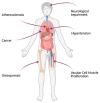Pleiotropic Effects of Acetylsalicylic Acid after Coronary Artery Bypass Grafting-Beyond Platelet Inhibition
- PMID: 34073241
- PMCID: PMC8198192
- DOI: 10.3390/jcm10112317
Pleiotropic Effects of Acetylsalicylic Acid after Coronary Artery Bypass Grafting-Beyond Platelet Inhibition
Abstract
Acetylsalicylic acid (ASA) is one of the most frequently used medications worldwide. Yet, the main indications for ASA are the atherosclerosis-based cardiovascular diseases, including coronary artery disease (CAD). Despite the increasing number of percutaneous procedures to treat CAD, coronary artery bypass grafting (CABG) remains the treatment of choice in patients with multivessel CAD and intermediate or high anatomical lesion complexity. Taking into account that CABG is a potent activator of inflammation, ASA is an important part in the postoperative therapy, not only due to ASA antiplatelet action, but also as an anti-inflammatory agent. Additional benefits of ASA after CABG include anticancerogenic, hypotensive, antiproliferative, anti-osteoporotic, and neuroprotective effects, which are especially important in patients after CABG, prone to hypertension, graft occlusion, atherosclerosis progression, and cognitive impairment. Here, we discuss the pleiotropic effects of ASA after CABG and provide insights into the mechanisms underlying the benefits of treatment with ASA, beyond platelet inhibition. Since some of ASA pleiotropic effects seem to increase the risk of bleeding, it could be considered a starting point to investigate whether the increase of the intensity of the treatment with ASA after CABG is beneficial for the CABG group of patients.
Keywords: ASA; Alzheimer’s disease; CABG; acetylsalicylic acid; atherosclerosis; cancer; coronary artery bypass grafting; hypertension; inflammation; osteoporosis.
Conflict of interest statement
The authors declare no conflict of interest.
Figures



Similar articles
-
Acetylsalicylic acid treatment until surgery reduces oxidative stress and inflammation in patients undergoing coronary artery bypass grafting.Eur J Cardiothorac Surg. 2013 Jun;43(6):1154-63. doi: 10.1093/ejcts/ezs591. Epub 2012 Dec 2. Eur J Cardiothorac Surg. 2013. PMID: 23209276 Clinical Trial.
-
Homocysteine is a novel risk factor for suboptimal response of blood platelets to acetylsalicylic acid in coronary artery disease: a randomized multicenter study.Pharmacol Res. 2013 Aug;74:7-22. doi: 10.1016/j.phrs.2013.04.010. Epub 2013 May 7. Pharmacol Res. 2013. PMID: 23665469 Clinical Trial.
-
A randomized, parallel group, double-blind study of ticagrelor compared with aspirin for prevention of vascular events in patients undergoing coronary artery bypass graft operation: Rationale and design of the Ticagrelor in CABG (TiCAB) trial: An Investigator-Initiated trial.Am Heart J. 2016 Sep;179:69-76. doi: 10.1016/j.ahj.2016.05.017. Epub 2016 Jun 18. Am Heart J. 2016. PMID: 27595681 Clinical Trial.
-
Antiplatelet therapy for patients undergoing coronary artery bypass surgery.Kardiol Pol. 2018;76(6):945-952. doi: 10.5603/KP.a2018.0111. Epub 2018 May 21. Kardiol Pol. 2018. PMID: 29781070 Review.
-
The use of platelet function testing in PCI and CABG patients.Blood Rev. 2014 May;28(3):109-21. doi: 10.1016/j.blre.2014.03.004. Epub 2014 Apr 1. Blood Rev. 2014. PMID: 24745727 Review.
Cited by
-
Forging Ahead in Cardiovascular Disease Management.J Clin Med. 2023 Sep 3;12(17):5739. doi: 10.3390/jcm12175739. J Clin Med. 2023. PMID: 37685805 Free PMC article.
-
D,L-Lysine-Acetylsalicylate + Glycine (LASAG) Reduces SARS-CoV-2 Replication and Shows an Additive Effect with Remdesivir.Int J Mol Sci. 2022 Jun 21;23(13):6880. doi: 10.3390/ijms23136880. Int J Mol Sci. 2022. PMID: 35805887 Free PMC article.
-
Gene Expression Profiling of Markers of Inflammation, Angiogenesis, Coagulation and Fibrinolysis in Patients with Coronary Artery Disease with Very High Lipoprotein(a) Levels Treated with PCSK9 Inhibitors.J Cardiovasc Dev Dis. 2022 Jul 1;9(7):211. doi: 10.3390/jcdd9070211. J Cardiovasc Dev Dis. 2022. PMID: 35877573 Free PMC article.
References
-
- Ruel M., Kulik A. Secondary prevention after coronary artery bypass graft surgery: Presentation of a scientific statement. Can. J. Cardiol. 2014;30:S237. doi: 10.1016/j.cjca.2014.07.403. - DOI
-
- Developed with the special contribution of the European Association for Percutaneous Cardiovascular Interventions (EAPCI) Wijns W., Kolh P., Danchin N., Di Mario C., Falk V., Folliguet T., Garg S., Huber K., James S., et al. Guidelines on myocardial revascularization: The Task Force on Myocardial Revascularization of the European Society of Cardiology (ESC) and the European Association for Cardio-Thoracic Surgery (EACTS) Eur. Heart J. 2010;31:2501–2555. - PubMed
-
- Bachar B.J., Manna B. StatPearls. StatPearls Publishing; Treasure Island, FL, USA: 2021. Coronary Artery Bypass Graft. - PubMed
Publication types
LinkOut - more resources
Full Text Sources
Miscellaneous

